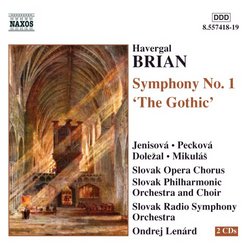| All Artists: Havergal Brian, Ondrej Lenard, Slovak Philharmonic Orchestra, Slovak Radio Symphony Orchestra (Bratislava), Slovak Radio Symphony Orchestra Bratislava, Eva Jenisova, Vladimir Dolezal Title: Havergal Brian: Symphony No. 1 'The Gothic' Members Wishing: 1 Total Copies: 0 Label: Naxos Release Date: 6/15/2004 Genre: Classical Styles: Opera & Classical Vocal, Symphonies Number of Discs: 2 SwapaCD Credits: 2 UPC: 747313241828 |
Search - Havergal Brian, Ondrej Lenard, Slovak Philharmonic Orchestra :: Havergal Brian: Symphony No. 1 'The Gothic'
 | Havergal Brian, Ondrej Lenard, Slovak Philharmonic Orchestra Havergal Brian: Symphony No. 1 'The Gothic' Genre: Classical
|
Larger Image |
CD DetailsSimilar CDs |
CD ReviewsFinally! From Marco Polo to Naxos. And affordable! Bob Zeidler | Charlton, MA United States | 08/01/2004 (5 out of 5 stars) "Klaus Heymann, the founder of these two labels, was courageous a number of years back, when he released Havergal Brian's 'Gothic' Symphony on his full-price Marco Polo label. I would guess that the album has been a steady, if slow, seller over those years, as it has been the only available recording of this marvelously idiosyncratic work. My own copy, played at least annually (almost ritualistically so) has served me well for most of those years. I've long wanted to introduce this work to friends, but for some of them cost, and, to an extent, availability, have stood in the way. No longer! Heymann has done the right thing by releasing this album on his budget Naxos label, and it is now affordable to all. And, as I note later, it is better than the Marco Polo original in more than just price. The 'Gothic' may well be the most talked-about-yet-not-listened-to classical work ever. Many seem to have opinions on it whether they've listened to it or not (in which case, the work may well hold two records: the largest symphony in terms of orchestral forces, and the most misunderstood as well). The 'Gothic' inevitably gets compared, largely incorrectly, with a handful of other works with which it has little in common: Gustav Mahler's 8th Symphony ('The Symphony of a Thousand') most often, but also the symphonies of Anton Bruckner, the 'Grand Messe des Morts,' 'Te Deum' and 'La Damnation de Faust' of Hector Berlioz, and even, on occasion, Arnold Schoenberg's early 'Gurre-Lieder.' But such similarities exist mostly at the margins; the 'Gothic' is a true sui generis work owing no measurable debt to these. The greatest similarity is to the Mahler work. Both are divided into two unequal parts, in roughly 1/3 to 2/3 proportions; both utilize Goethe's 'Faust' and medieval hymns for inspiration (but Brian and Mahler invert the order of these two sources), and both call for huge orchestral and choral resources. But comparison ends there; the 'Gothic' hasn't the cumulative inevitability of the Mahler work, and is quite different in all other respects. Nor has the 'Gothic' the granitic architectonics of Bruckner's symphonies (although there are a few brass chorale passages reminiscent of Bruckner), or the equally idiosyncratic brilliance of the three Berlioz works despite the 'Gothic' being inspired by 'Faust,' having some of its orchestral forces spatially arrayed as in the 'Grand Messe des Morts,' and having its massive Part II set to the 'Te Deum' text. Anyone familiar with British music of the period the 'Gothic' was written in will recognize this as a British work: Except in the most idiosyncratic places (of which there is no shortage), the work is British to the core, with passages that alternately remind one of an entire host of such composers. Bax, Butterworth, Holst and Vaughan Williams come to mind, and Elgar is seldom far away. (While Brian came from a working class background and had been, at least in part, an autodidact, he was already known and respected by his British peers prior to the 'Gothic.') To be sure, the 'Gothic' is a huge, sprawling work, seemingly evolving as a series of tableaux full of original themes and orchestrational touches, as well as choral writing that was years ahead of its time in its harmonic daring and vocal density. The episodic style, and the frequent punctuations of the 'Gothic' by march music, remind me as much of Mahler's 3rd Symphony as the work reminds others of Mahler's 8th Symphony. (One such march, a quirky one scored for nine unison clarinets and side drum, is particularly intriguing.) Moreover, there is a 'long arc' to the work not unlike the Mahler 3rd that could be said to represent a journey from 'darkness into light.' Brian began the work in the shadow of the end of the Great War; to him, 'Gothic' symbolized the emergence from the Dark Ages into something better and brighter. But, whereas the Mahler work ends in a blaze of glory, the 'Gothic' ends, after its journey of considerable length, in a softly diatonic yet enigmatic sense of a capella choral repose. To me, it is as if he is uncertain that the 'enduring timelessness' of the Gothic cathedral, as metaphor, is all that enduring, following the horrors of the Great War he experienced first-hand. This is not an easy work, so rich with ideas as it is, to grasp at first hearing. (A wealth of information on the work, as 'symphony qua symphony,' and as metaphor, can be found at musicweb.uk.net/brian/sym1.htm.) But it is certainly not difficult to enjoy it, and, over time, build one's own cumulative sense of its logic. The high quality of the performance belies its origins and makes a splendid argument for the work's own qualities. This Naxos release is an improvement over its Marco Polo predecessor in ways other than just cost. The sound is noticeably clearer, particularly in the densest passages, which had a fair bit of congestion and distortion. (This improvement comes at the expense of recording level, which is slightly, but observably, lower, probably by 4 - 6 dB.) The album is now in a 'slimline' 2-CD jewel box that takes up less shelf space. There has been no significant attempt at cost cutting for the booklet, which faithfully duplicates the material in the Marco Polo release, save for brief notated musical examples and two color photographs. In exchange, the Naxos notes include even more information on the forces used in the recording, with biographical details about the vocal soloists and further information on the orchestras and choruses. As before, the discs are generously indexed, with musical references to the index points (a total of 46) clearly stated in the booklet notes. For many coming upon this work for the first time, these notes and index points will help them understand this weird yet wonderful work. VERY highly recommended! Bob Zeidler" Interesting Composer J. Rich | 10/26/2009 (4 out of 5 stars) "Havergal Brian was a unique English composer born in 1876 and lived much of his composing life in the shadows and in total obscurity. He never achieved much attention for his music during his life. Some of his music is actually quite difficult to listen to and not difficult in a Vaughan Williams 6th symphony kind of way either. His first symphony "The Gothic" is a mammoth work that lasts around 1 hour and 54 minutes in length and calls for huge orchestral forces: there are two orchestras, five vocal soloists, and seven choirs, which includes two children's choirs. This symphony is also in the Guinness Book of World Records for largest symphony ever composed. Superlatives aside, I have listened to this recording four times all the way through and on different days during the week and the music itself is quite interesting. I don't want to draw comparisons with any other composers, because this symphony is truly in a class by itself. Nobody sounds like Havergal Brian. "The Gothic" is divided into two parts: the first being more instrumentally inclined and the second is choral. Brian also had an unusual way of dividing up symphonies. Instead of traditional four movements, he would have say four movements, but each movement is divided up into sections. This alone is very odd, but there is no division in changing tracks, it is completely seamless. A really strange way to divide up a symphony, but in a way it works in this case. Many of his other symphonies are divided in this manner as well. The actual music uses huge brass chorales, marches, slow almost dance-like movements, loud dissonant string and brass passages. I didn't really hear much playing in the woodwinds, although in the first part towards the beginning there was some, but I seldom heard hardly anything from this section. I don't know if it was the way it was recorded or what, but the brass, strings, and percussion seems to drown them out. The second part has some very interesting choral writing almost medieval-like in some sections. Throughout the entire symphony there are flashes of brilliance and I can hear a beautiful melody being played, but this only lasts for a few measures. Most of this symphony is borderline grotesque. That's not to say it doesn't have it's beautiful parts, because it does, but it seems that Brian wanted to bring out this element in this symphony. As for the inspiration for the symphony, I'm not really sure where he got his inspiration from, but I have read that he may have took inspiration from gothic architecture. I do know it took Brian eight years to complete this symphony. The reason I'm withholding one star is because of the sound quality. It's not bad, especially given the circumstances of recording a work of this size, there are many passages in the second part where the orchestra is almost inaudible. I have the Naxos recording and I heard it's of signifigant improvement over the Marco Polo release. Another problem is the actual volume level, which Mr. Zeidler explains in his excellent review. The performances from all these orchestras and choruses are absolutely astonishing. It's not a perfect performance though, but I think the conductor Ondrej Lenard and the Naxos team should be commended for recording this symphony. There are also some excellent liner notes that discuss the recording and the forces it took to make all of this happen. All of this said, this is an absolutely intriguing symphony and great fun to listen to. I'm still really digesting all of this music as some of it is very challenging, but overall this is a rewarding listening experience for any classical fan. This is the only commerical recording we have of this symphony as well, so until something else comes along, this will be the only opportunity anyone has of hearing this work." Like a new recording Alan Dean Foster | prescott, az | 08/07/2008 (5 out of 5 stars) "Having previously reviewed the original Marco Polo release for Amazon, there is little I can add to what Mr. Zeidler says, except to emphasize that the increase in clarity of the Naxos release over its predecessor is not only noticeable but in some places remarkable. Having listened to the MP edition well over a hundred times, in playing the Naxos I immediately heard numerous details I had previously missed The woodwinds in particular benefit from the increased clarity on this release.
If you already have the MP release, add this one to your collection. It is the nearest thing we're likely to have to a new recording for some time. And buy it for your friends...." |

 Track Listings (25) - Disc #1
Track Listings (25) - Disc #1
